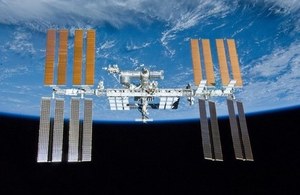New UK projects look at the impact of spaceflight on the human body
The impact of spaceflight on the human body will be examined in new projects worth £500,000, the UK Space Agency announced today.

By supporting this research, the Agency will enhance the UK’s capabilities in space exploration and support areas that can lead to the development of new technologies.
The funding, from the Agency’s Microgravity Science Programme, will help scientists with upcoming experiments in European Space Agency microgravity facilities, including the International Space Station and parabolic flights which provide short bursts of weightless conditions, just like in orbit.
Libby Jackson, Human Spaceflight and Microgravity Programme Manager, said:
We are delighted to be supporting the growing microgravity science community in this research. These exciting experiments will further our understanding of how the human body copes with the challenging environment of living and working in space, which in turn will help humans to carry out more research in space.
The three projects, which have been awarded a total of £534,421, are:
Exploration Studentship: Molecular basis of muscle alteration in response to spaceflight – Professor Nate Szewczyk, University of Nottingham - £59,196
Professor Nate Szewczyk, from the University of Nottingham, is the Principle Investigator of the Molecular Muscle experiment, due to be flown to the International Space Station (ISS) on SpaceX-16 flight at the end of 2018. This grant will support a post-graduate student to work with the experiment team, receiving training in the conduct of molecular mechanistic experiments to further understand why muscle declines in response to spaceflight and, potentially, how it can be countered as well as gaining experience in the conduct of an actual life sciences spaceflight mission to the International Space Station.
The long-term goal of crewed missions to Mars poses technical challenges with respect to engineering appropriate spacecraft and associated subsystems as well as with preserving human health on long duration space missions. One of the potentially mission limiting health risks that has been identified for Mars missions is the decline of muscle strength and aerobic capacity. Over a number of years and spaceflight missions a consistent set of molecules has been identified that change in response to spaceflight and do so not only in astronaut muscle but also in other animals such as mice and worms. By conducting experiments in worms on Earth, researchers have found that they have been able to change the response of the molecules that change in response to spaceflight. Thus, they will now attempt to use these gene and drug therapies on board the International Space Station to see if they can alter the response of worm muscle to spaceflight.
Muscle Tone in Space – Professor Maria Stokes, University of Southampton - £191,892
Professor Maria Stokes, from the University of Southampton, is part of the international team behind the Myotones experiment, led by Professor Dieter Blottner, of the Charité Universitätsmedizin Berlin, which will take place on the International Space Station (ISS) in the coming years.
The tone of a resting muscle is affected by tissue called fascia, as well as the tissue within the muscle itself and these shape the human resting muscle tone (HRMT) system. Changes in the HRMT system and the effects on function due to microgravity have yet to be studied directly. This project aims to monitor muscle health of crew members by non-invasive, objective measurement of biomechanical properties of muscles pre-, in- and post-flight.
The two technologies used are Myoton and ultrasound imaging of musculoskeletal tissues. Ultrasound images will be used to measure muscle thickness to see how this changes over time, from pre-flight to inflight and pos-flight periods. The MyotonPRO device offers a hand-held, user-friendly and non-invasive measurement method to test key biomechanical parameters of the superficial skeletal muscles, tendons and other soft biological tissues.
Development and evaluation of countermeasures to prevent spinal antigravity muscle deconditioning in simulated partial- and micro-gravity – Professor Nick Caplan, University of Northumbria, £283,333
Professor Nick Caplan and his team are working to mitigate injury risk and maintain operational effectiveness in astronauts by understanding how spinal anti-gravity muscles are affected by reduced gravity, and how their condition can be preserved by artificial gravity exposure or recovered through exercise. This will be done through participation in the International Space Life Sciences Working Group parabolic flight campaign (2018) and the NASA/ESA Artificial Gravity Bedrest Study (2018-19) using techniques that they have developed to assess the role of these muscles during postural control in low back pain. Working in partial gravity conditions (e.g. Moon and Mars) will lead to musculoskeletal deconditioning in astronauts that will increase spinal injury risk and reduce operational effectiveness, risking mission failure. This study will demonstrate how partial gravity influences spinal antigravity muscle activity and spinal postural control. This knowledge will enable effective countermeasure development for long duration human habitation of Moon and Mars.